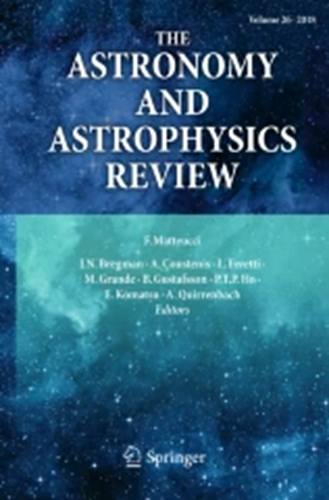银河凸出后的VVV星系的过度密度
IF 26.5
1区 物理与天体物理
Q1 ASTRONOMY & ASTROPHYSICS
引用次数: 1
摘要
我们研究了一个面积为1.636平方度的区域,对应于VVV瓷砖$b204$。使用SExtractor,我们分析了光度数据,生成了该地区扩展源的目录。为了确认这些来源是候选星系,我们通过视觉检查RGB图像寻找典型的星系特征。使用2MASX和GCMW编目源,我们测试了我们的目录的完整性和污染,并定义了合适的颜色切割来选择星系。我们还将观测结果与暗物质模拟的两个半解析模型的结果进行了比较。用SAG星系形成半解析模型构建了一个星系目录,用L-Galaxies半解析模型构建了另一个星系目录。通过采用CLASS-STAR$ 0.7$ arcsec和特定的颜色切割(J-Ks$>$0.97, J-H$>$0和H-Ks$>$0),我们生成了一个扩展源的自动目录。经过目视检查,我们确定了624个源,其中10个<$Ks <$17作为候选星系。当把肉眼确认的星系视为可靠的天体时,自动目录的污染是28%。在Ks=13.5震级范围内,估计的完备性为87%。我们分析了候选星系的空间分布,发现在半径15角分的小区域内星系高度集中。这个区域的密度是同类区域的三倍。我们将这个小区域内的星系数量与从半解析模型中获得的合适星系样本的平均密度值进行了比较,发现我们的结果与一个过密度区域一致。利用VVV近红外数据和模拟星表,我们发现了其他星表没有发现的新的河外源。我们证明了VVV调查研究大量星系候选者和被银河系遮蔽的星系外结构的潜力。本文章由计算机程序翻译,如有差异,请以英文原文为准。
Overdensity of VVV galaxies behind the Galactic bulge
We studied a region of 1.636 square degrees corresponding to the VVV tile $b204$. Using SExtractor, we analysed photometric data generating a catalogue of extended sources in this area. In order to confirm these sources as galaxy candidates we visually inspected RGB images looking for typical galaxy features. Using 2MASX and GCMW catalogued sources we tested completeness and contamination of our catalogue and define suitable colour cuts to select galaxies. We also compared the observational results with those obtained from two semi-analytical models on Dark Matter simulations. One galaxy catalogue was constructed with the SAG semi-analytic model of galaxy formation, and the other one was constructed with the L-Galaxies semi-analytic model.By adopting CLASS-STAR$ 0.7$ arcsec and specific colour cuts (J-Ks$>$0.97, J-H$>$0 and H-Ks$>$0) we generated an automatic catalogue of extended sources. After visual inspection we identified 624 sources with 10$<$Ks$<$17 as galaxy candidates. The contamination of the automatic catalogue is 28% when considering visually confirmed galaxies as reliable objects. The estimated completeness is 87% up to magnitude Ks=13.5. We analysed the spatial distribution of galaxy candidates, finding a high concentration of galaxies in a small region of 15 arcmin radius. This region has three times higher density than similar areas in the tile. We compared the number of galaxies in this small area with the mean density values obtained from a suitable sample of galaxies from semi-analytic models finding that our results are consistent with an overdensity region. Using VVV near-infrared data and mock catalogues we detect new extragalactic sources that have not been identified by other catalogues. We demonstrate the potentiality of the VVV survey studying a large number of galaxy candidates and extragalactic structures obscured by the Milky Way.
求助全文
通过发布文献求助,成功后即可免费获取论文全文。
去求助
来源期刊

The Astronomy and Astrophysics Review
地学天文-天文与天体物理
CiteScore
45.00
自引率
0.80%
发文量
7
期刊介绍:
The Astronomy and Astrophysics Review is a journal that covers all areas of astronomy and astrophysics. It includes subjects related to other fields such as laboratory or particle physics, cosmic ray physics, studies in the solar system, astrobiology, instrumentation, and computational and statistical methods with specific astronomical applications. The frequency of review articles depends on the level of activity in different areas. The journal focuses on publishing review articles that are scientifically rigorous and easily comprehensible. These articles serve as a valuable resource for scientists, students, researchers, and lecturers who want to explore new or unfamiliar fields. The journal is abstracted and indexed in various databases including the Astrophysics Data System (ADS), BFI List, CNKI, CNPIEC, Current Contents/Physical, Chemical and Earth Sciences, Dimensions, EBSCO Academic Search, EI Compendex, Japanese Science and Technology, and more.
 求助内容:
求助内容: 应助结果提醒方式:
应助结果提醒方式:


